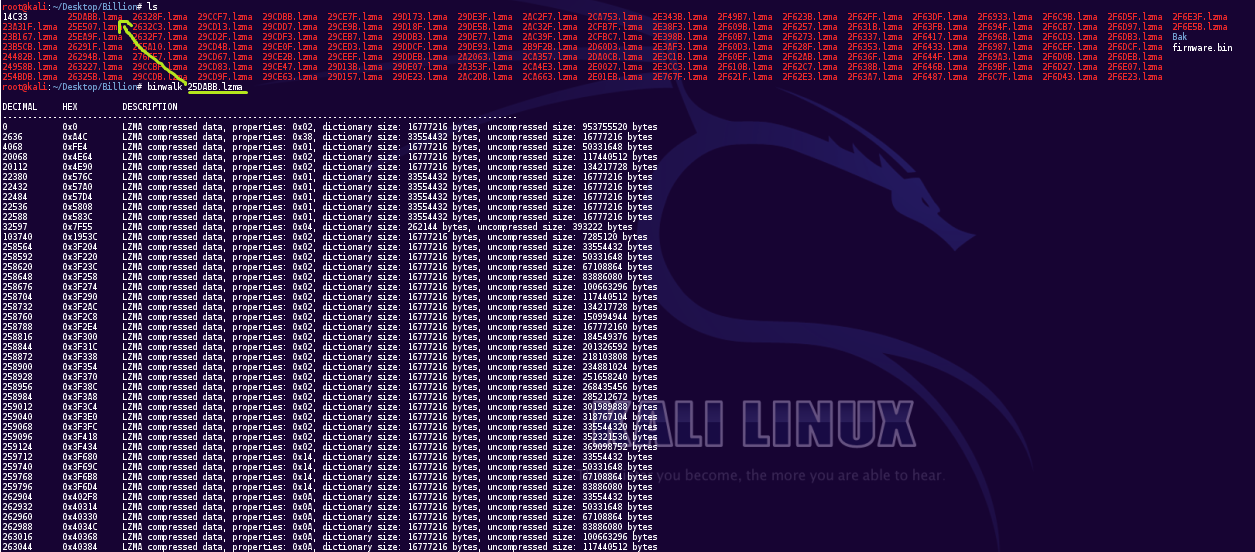The output from the file utility, as you've probably guessed, is a false positive. The beginning of the firmware.bin file contains what looks to be a basic header (note the "SIG" string near the beginning of the file), and a bunch of MIPS executable code, which is likely the bootloader:
DECIMAL HEX DESCRIPTION
-------------------------------------------------------------------------------------------------------------------
196 0xC4 MIPS instructions, function epilogue
284 0x11C MIPS instructions, function epilogue
372 0x174 MIPS instructions, function epilogue
388 0x184 MIPS instructions, function epilogue
416 0x1A0 MIPS instructions, function epilogue
424 0x1A8 MIPS instructions, function prologue
592 0x250 MIPS instructions, function epilogue
712 0x2C8 MIPS instructions, function epilogue
720 0x2D0 MIPS instructions, function prologue
832 0x340 MIPS instructions, function epilogue
840 0x348 MIPS instructions, function prologue
912 0x390 MIPS instructions, function epilogue
920 0x398 MIPS instructions, function prologue
976 0x3D0 MIPS instructions, function epilogue
984 0x3D8 MIPS instructions, function epilogue
1084 0x43C MIPS instructions, function epilogue
1192 0x4A8 MIPS instructions, function epilogue
1264 0x4F0 MIPS instructions, function epilogue
...
Running strings on the firmware.bin binary seems backup this hypothesis, with many references to checksum and decompression errors:
checksum error! (cal=%04X, should=%04X)
signature error!
(Compressed)
start: %p
unmatched objtype between memMapTab and image!
Length: %X, Checksum: %04X
Version: %s,
Compressed Length: %X, Checksum: %04X
memMapTab Checksum Error! (cal=%04X, should=%04X)
memMapTab Checksum Error!
%3d: %s(%s), start=%p, len=%X
%s Section:
memMapTab: %d entries, start = %p, checksum = %04X
$USER Section:
signature error!
ROMIO image start at %p
code length: %X
code version: %s
code start: %p
Decompressed image Error!
Decompressed image Checksum Error! (cal=%04X, should=%04X)
ROM length(%X) > RAM length (%X)!
Can't find %s in $ROM section.
Can't find %s in $RAM section.
RasCode
A quick examination of the strings in the two decompressed LZMA files you found shows that the smaller one (at offset 0x14C33) appears to contain some debug interface code, likely designed to be accessed via the device's UART:
UART INTERNAL LOOPBACK TEST
UART EXTERNAL LOOPBACK TEST
ERROR
======= HTP Command Listing =======
< press any key to continue >
macPHYCtrl.value=
MAC INTERNAL LOOPBACK TEST
MAC EXTERNAL LOOPBACK TEST
MAC INTERNAL LOOPBACK
MAC EXTERNAL LOOPBACK
LanIntLoopBack ...
Tx Path Full, Drop packet:%d
0x%08x
tx descrip %d:
rx descrip %d:
%02X
%08X:
< Press any key to Continue, ESC to Quit >
0123456789abcdefghijklmnopqrstuvwxyz
0123456789ABCDEFGHIJKLMNOPQRSTUVWXYZ
<NULL>
) Register Dump *****
***** ATM SAR Module: VC(
Reset&Identify reg =
Traffic Sched. TB reg=
TX Data ctrl/stat reg=
RX Data ctrl/stat reg=
Last IRQ Status reg =
IRQ Queue Entry len =
VC IRQ Mask register =
TX Data Current descr=
RX Data Current descr=
TX Traffic PCR =
TX Traffic MBS/Type =
TX Total Data Count =
VC IRQ CC Mask reg =
TX CC Current descr =
TX CC Total Count =
RX Miss Cell Count =
***** ATM SAR Module: Common Register Dump *****
The second larger file (at offset 0x55433) appears to contain the ThreadX RTOS, by Green Hills:
RTA231CV Reserved String
anonymous
www.huawei.com
1000
tc-e4f6ed2f5b87<
MSFT 5.07
user<
MSFT 5.07
LXT972
"AC101L
CIP101
RTL8201
CAC201
jjjjjjjjjjjjjjjjjjjjjjjjjjjjjjjjjjjjjjjjjjjjj
jjjjjjjjjjjjjjjjjjjjjjjjjjjjjjjjjjjjjjjjjjjjj
jjjjjjjj
jjjjjjjjjjjjjjjjjjjjjjjjjjjjjjjjjjjjjjjjjjjjj
jjjjjjjjjjjjjjjjjjjjjjjjjjjjjjjjjjjjjjjjjjjjj
jjjjjjjjjjjjjjjjjjjjjjjjjjjjjjjjjjjjjjjjjjjjj
jjjjjjjj
jjjjjjjjjjjjjjjjjjjjjjjjjjjjjjjjjjjjjjjjjjjjj
System Timer Thread
Copyright (c) 1996-2000 Express Logic Inc. * ThreadX R3900/Green Hills Version G3.0f.3.0b *
If you aren't familiar with RTOS's, they typically are just one big kernel with no concept of user space vs kernel space or what you would think of as a normal file system, although they will contain things like images and HTML files for this device's Web interface (see here for an example of how these types of files are stored/accessed in some VxWorks systems).
I'd say that you already pretty much have this firmware extracted into its basic parts. To further analyze the bootloader or the two extracted LZMA files, you will need to start disassembling those files, which entails determining the memory address where they are loaded at boot time, identifying code/data sections, looking for possible symbol tables, identifying common functions, and probably writing some scripts to help with all of the above.
